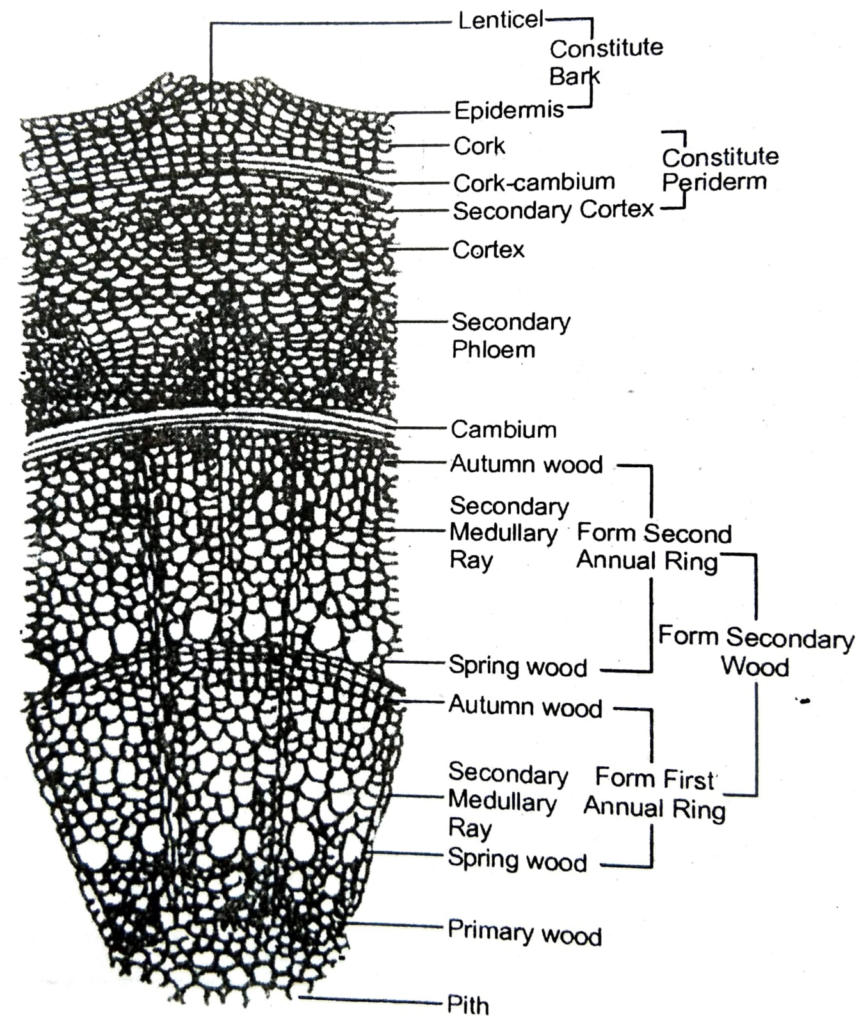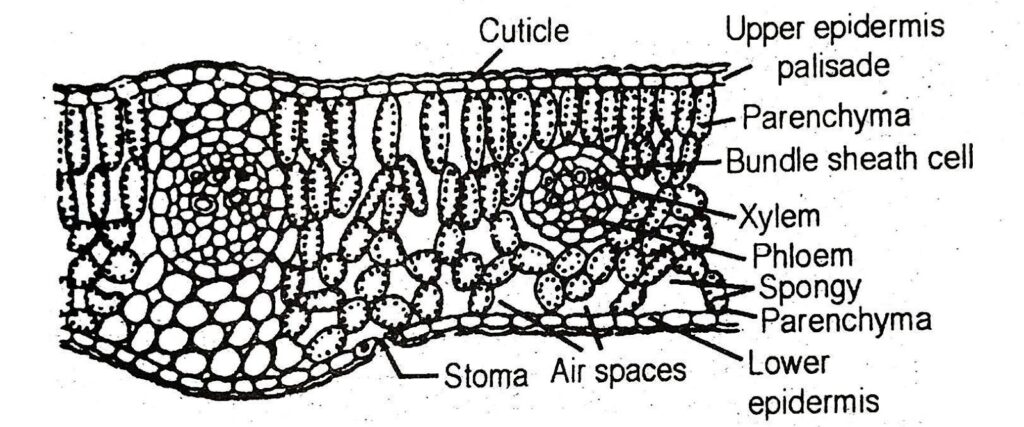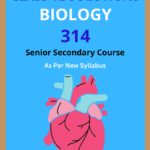NIOS Class 12 Biology Chapter 7 Shoot System Solutions to each chapter is provided in the list so that you can easily browse throughout different chapters NIOS Class 12 Biology Chapter 7 Shoot System Notes and select need one. NIOS Class 12 Biology Chapter 7 Shoot System Question Answers Download PDF. NIOS Study Material of Class 12 Biology Notes Paper 314.
NIOS Class 12 Biology Chapter 7 Shoot System
Also, you can read the NIOS book online in these sections Solutions by Expert Teachers as per National Institute of Open Schooling (NIOS) Book guidelines. These solutions are part of NIOS All Subject Solutions. Here we have given NIOS Class 12 Biology Chapter 7 Shoot System Solutions, NIOS Senior Secondary Course Biology Solutions for All Chapter, You can practice these here.
Shoot System
Chapter: 7
MODULE – II: FORM AND FUNCTION OF PLANTS AND ANIMALS
NIOS TEXTBOOK QUESTIONS ANSWERS
INTEXT QUESTIONS 7.1
1. Name the part of plant which bears nodes, leaves and flowers.
Ans. Stem.
2. Lateral branch develops from which bud?
Ans. Axillary buds.
3. Why is it difficult to break lateral roots and not lateral branches on stem?
Ans. Because lateral roots originate from inner layers (endogenous origin).
4. Roots are negatively phototropic and positively geotropic, what pattern of growth does the stem show?
Ans. The stem in positively phototrophic and negatively geotropic.
INTEXT QUESTIONS 7.2
1. Name the meristematic zone in which cells divide in all planes.
Ans. Corpus.
2. From which meristematic layer does the vascular tissue develops?
Ans. Procambium.
3. Which structure give rise to a lateral branch? Name the type of its origin. bud, exogenous.
Ans. Axillary.
4. What is the structure known as which covers the apical meristem of root but is absent in stem.
Ans. Root cap.
INTEXT QUESTION 7.3
1. What are plants with weak stem trailing on the ground known as?
Ans. Creeper plants.
2. Name the modification to which Runner, Stolon, Offset and Sucker belong.
Ans. Sub-aerial stem.
3. What is a phylloclade with one or two internodes called?
Ans. Cladode.
4. ‘Haldi’ and onion belong to which category of stem modification respectively?
Ans. (i) Rhizome.
(ii) Bulb.
5. Match the items of column A with those of column B:
| Column A | Column B |
| (a) Tendril | (i) Protection |
| (b) Sucker | (ii) Perennation |
| (c) Thorns | (iii) Reproduction |
| (d) Bulb | (iv) Photosynthesis |
| (e) Phylloclade | (v) Climbing |
Ans.
| Column A | Column B |
| (a) Tendril | (v) Climbing |
| (b) Sucker | (iii) Reproduction |
| (c) Thorns | (i) Protection |
| (d) Bulb | (ii) Perennation |
| (e) Phylloclade | (iv) Photosynthesis |
INTEXT QUESTIONS 7.4
1. Give one primary function of stem.
Ans. Conduction of water and minerals from root to leaf.
2. How does sugarcane plant multiply?
Ans. By stem cuttings.
3. Match the following in column A with column B:
| Column A | Column B |
| (a) Opuntia | (i) Conduction |
| (b) Duranta | (ii) Storage of food |
| (c) Ginger | (iii) Photosynthesis |
| (d) Potato | (iv) Perennation |
| (e) Stem | (v) Protection fair |
Ans.
| Column A | Column B |
| (a) Opuntia | (iii) Photosynthesis |
| (b) Duranta | (v) Protection fair |
| (c) Ginger | (iv) Perennation |
| (d) Potato | (ii) Storage of food |
| (e) Stem | (i) Conduction |
INTEXT QUESTIONS 7.5
1. Differentiate between conjoint and collateral vascular bundle.
Ans. Conjoint: When xylem and phloem are together in one bundle.
Collateral: When xylem and phloem are on same radius.
2. What is the region between two vascular bundles in a dicot stem known as?
Ans. Medullary ray.
3. Where will you find radially arranged vascular bundles with exarch xylem?
Ans. In root.
4. If you want to study the internal structure of a monocot and a dicot stem, name the plants you would select for the study.
Ans. (i) Monocot stem-Maize.
(ii) Dicot stem-Sunflower.
INTEXT QUESTIONS 7.6
1. Name the two lateral meristems which are responsible for increase in girth of stem.
Ans. Cork cambium phellogen and vascular cambium.
2. From which region does the interfascicular cambium develop?
Ans. Medullary ray parenchyma.
3. Define bark.
Ans. The tissue outside functional cork cambium is known as the bark.
4. Why are lenticels, non-suberized?
Ans. For gaseous exchange in branches of a plant.
5. The stems of grasses, rice, remain weak and thin, why?
Ans. As they need support.
6. Which layers constitute the periderm? What is it’s function?
Ans. (i) Phellem, Phellogen, Phelloderm.
(ii) Its function is protection.
INTEXT QUESTIONS 7.7
1. Which type of wood is formed when the cambium is less active?
And. Late of summer wood.
2. How can you determine the age of a tree?
Ans. By counting the annual rings.
3. Why is heart wood commercially more valuable?
Ans. Durable, resistant to attack of pathogen.
4. Why does a tall tree stand erect even in strong wind and lashing rain?
Ans. Presence of abundant mechanical tissue such as sclerenchyma and secondary xylem.
5. Define wood.
Ans. The wood is “secondary xylem produced by activity of vascular cambium in dicot stem”.
INTEXT QUESTIONS 7.8
1. Define venation.
Ans. It is defined as “arrangement of veins and veinlets in lamina of the leaf”.
2. Differentiate between unicostate and multicostate venation.
Ans. The unicostate has one strong midrib but while the multicostate has several strong veins.

3. What is the type of venation found in peepal and palm leaves?
Ans. Reticulate venation in peepal; parallel in palm leaves.

Fig. 7.39. Palmately compound leaf and its Types.

Fig. 7.40. Pinnately compound leaves and its Types.
4. Name the structure which arises in the axil of leaf.
Ans. Axillary bud.
5. What is the prominent vein called which is present in the middle of lamina and runs from base to apex?
Ans. Midrib.
INTEXT QUESTIONS 7.9
1. Name the structure to which the leaflets are attached in a compound leaf.
Ans. Rachis.
2. What is the structure which helps you differentiate a leaf from a leaflet?
Ans. The presence of axillary bud in leaf but not in leaflet.
3. What are the two types of compound leaves known as?
Ans. Pinnately and palmately compound leaf.
INTEXT QUESTIONS 7.10
1. What is the type of phyllotaxy found in mango, ‘tulsi’ and guava plants?
Ans. (i) Alternate.
(ii) opposite-decussate.
(iii) opposite-superposed.
2. Match the following of column A with that of column B:
| Column A | Column B |
| (a) Pitcher | (i) Photosynthesis. |
| (b) Spines | (ii) Climbing. |
| (c) Phyllode | (iii) Trapping insects. |
| (d) Tendril | (iv) Protection. |
Ans.
| Column A | Column B |
| (a) Pitcher | (iii) Trapping insects. |
| (b) Spines | (iv) Protection. |
| (c) Phyllode | (i) Photosynthesis. |
| (d) Tendril | (ii) Climbing. |
3. Give two examples of insectivorous plants.
Ans. (i) Pitcher plant.
(ii) Bladderwort.
4. Water chestnut shows two different types of leaves on the same plant, what is such a condition known as?
Ans. Heterophylly.
INTEXT QUESTIONS 7.11
1. How is the mesophyll tissue of dicot leaf different from that of monocot leaf? What is its function?
Ans. The mesophyll differentiated into palisade and spongy tissue in dicot leaf but whereas only of spongy tissue in monocot leaf; photosynthesis is the function of mesophyll tissue.
2. Where are stomata located in a grass leaf?
Ans. In both surfaces of grass leaf.
3. Name the structure through which plants growing in humid areas get rid of excess of water in liquid form.
Ans. Hydathodes.
4. Match the following of column A with that of column B:
| Column A | Column B |
| (a) Bulliform cells | (i) Protection |
| (b) Transport of water and mineral salts | (ii) Guttation |
| (c) Stomata only on lower surface | (iii) Monocot leaf |
| (d) Hydathode | (iv) Dicot leaf |
| (e) Hair | (v) Stomata |
| (f) Exchange of gases | (vi) Xylem |
Ans.
| Column A | Column B |
| (a) Bulliform cells | (iii) Monocot leaf |
| (b) Transport of water and mineral salts | (vi) Xylem |
| (c) Stomata only on lower surface | (iv) Dicot leaf |
| (d) Hydathode | (ii) Guttation |
| (e) Hair | (i) Protect tion |
| (f) Exchange of gases | (v) Stomata |
INTEXT QUESTIONS 7.12
1. What is the collection of sepals and petals respectively known as?
Ans. (i) Collection of sepals Calyx.
(ii) Collection of petals = Corolla.
2. Match the following of column A with that of column B:
| Column A | Column B |
| (a) Flower | (i) China rose |
| (b) Polycarpellary | (ii) Pollination |
| (c) Petals | (iii) Reproductive organ |
| (d) Monodelphous | (iv) Many carpels |
| (e) Carpel | (v) Modified shoot |
Ans.
| Column A | Column B |
| (a) Flower | (v) Modified shoot |
| (b) Polycarpellary | (iv) Many carpels |
| (c) Petals | (ii) Pollination |
| (d) Monodelphous | (i) China rose |
| (e) Carpel | (iii) Reproductive organ |
3. Define placentation.
Ans. It is defined as “the manner in which placentae are distributed in the ovary”.
4. Name the type of placentation where ovary is many chambered and ovules are arranged on the central axis.
Ans. Axile placentation.
INTEXT QUESTIONS 7.13
1. What is a cymose inflorescence?
Ans. When the main axis ends in a flower and the growth is limited.
2. Give one difference between Raceme and Spike.
Ans. The flowers are stalked in raceme but flowers are sessile in spike in the inflorescence.
3. Define inflorescence.
Ans. It refers to “the arrangement of flowers on floral axis.”
4. Name the type of inflorescence found in sunflower and Fig.
Ans. Sunflower = Capitulum.
Fig. = Hypanthodium.
INTEXT QUESTIONS 7.14
1. Define fruit.
Ans. The fruit is defined as “a ripened ovary that develops after fertilisation.”
2. Give two examples of false fruits.
Ans. (i) Pear.
(ii) Apple.
3. What is the fruit wall known as which is formed by the ovary wall?
Ans. Pericarp.
4. Give the names of three layers of pericarp of a fleshy fruit.
Ans. (i) Epicarp.
(ii) mesocarp. and
(iii) endo carp.
5. Match the following of column A with that of column B
| Column A | Column B |
| (a) Apple | (i) Berry |
| (b) Hesperidium | (ii) Mesocarp |
| (c) Mango-edible part | (iii) Endosperm |
| (d) Coconut-edible part | (iv) Orange |
| (e) Tomato | (v) False fruit |
Ans.
| Column A | Column B |
| (a) Apple | (v) False fruit |
| (b) Hesperidium | (iv) Orange |
| (c) Mango-edible part | (ii) Mesocarp |
| (d) Coconut-edible part | (iii) Endosperm |
| (e) Tomato | (i) Berry |
TERMINAL EXERCISES
1. Differentiate between:
(i) Dicot stem and monocot stem.
Ans. Differences between Dicot and Monocot Stem:
| Dicot Stem | Monocot Stem |
| 1. Multicellular hairs may be present on the epidermis. | Multicellular hairs are absent on the epider-mis. |
| 2. Collenchymatous hypodermis. | Sclerenchymatous hypo- dermis. |
| 3. There are three parts of ground tissue-cortex, endodermis and pericycle. | There is no differentia-tion of ground tissue into cortex, endodermis and ground tissue. |
| 4. There are few vascular bundles. | Vascular bundles are many. They are scattered. |
| 5. Lysigenous cavity absent. | Lysigenous cavity present. |
(ii) Root and stem.
Ans. Difference Between Root and Stem:
| Stem | Root |
| 1. Exogenous in origin. | Endogenous in origin. |
| 2. Nodes and internodes absent. | Nodes and internodes present. |
| 3. Bears leaves. | Bears lateral root branches. |
| 4. Stem hairs are multi- cellular. | Root hairs are uni-cellular. |
| 5. Cuticle present. | Cuticle absent. |
| 6. Vascular bundles are conjoint and collateral | Vascular bundles are radial. |
| 7. Xylem endarch. | Exarch xylem. |
| 8. Pith occurs regularly | Pith may be absent. |
(iii) Racemose and cymose inflorescence.
Ans. Differences Between Racemose Inflorescence and Cymose Inflorescence:
| Racemose Inflorescence | Cymose Inflorescence |
| 1. Peduncle has unlimited growth. | Peduncle has limited growth. |
| 2. Main axis does not end in a flower. | Main axis ends in flower. |
(iv) Stomata and hydathode.
Ans. Distinction Between Stomata and Hydathodes:
| Stomata | Hydathodes |
| 1. Pores found in the epi-dermis of leaves. | Specialised pores called water. Vesicles at the leaf tip or margins in some leaves. |
| 2. Loss of water as vapours. | Loss of water as drop. |
(v) True fruit and false fruit.
Ans. Differences Between True Fruit False Fruit:
| True Fruit | False Fruit |
| 1. It develops from the ovary. | It develops from other parts of flower but ovary takes part also. |
| 2. Example: pea. | Example: Apple. |
(vi) Dicot and monocot leaf.
Ans. Difference between the Internal Structure of Dicot and Monocot Leaves:
| Dicot Leaves | Monocot Leaver |
| 1. Stomata are present in lower epidermis and scattered. | Stomata are present in both lower and upper epi-dermis and arranged in rows. |
| 2. Bulliform cells absent. | Bulliform cells present. |
| 3. Mesophyll is differen-tiated into spongy and palisade parenchyma. | Mesophyll is not differen-tiated into spongy and palisade parenchyma. |
| 4. Vascular system in the form of a network. | Vascular bundles are in rows and form parallelveins. |
2. Explain the different types of underground modified stem.
Ans. Underground Stems: They are of four main types:
(i) Rhizome.
(ii) Corm.
(iii) Bulb.
(iv) Tuber.
(i) Rhizome: It grows horizontally. It is flattened and fleshy stem. It bears nodes, scale leaves and the roots. Example: Ginger (adrak).
(ii) Corm: It grows vertically. It is thick, stout, fleshy and spherical at its base. It stands erect in the ground. Example: Colocasia.
(iii) Tuber: It is the tip of an underground stem. It has nodes. Adventitious roots are absent. Example: potato.
(iv) Bulb: The stem is reduced. It is diec like (discord). It has terminal bud. Its fleshy leaves are eaten, e.g. Onion, garlic.
3. Explain the process of secondary growth in dicot stem.
Ans. The process of Secondary growth in a Dicot Stem: In a dicot plant stem cambium is located between phloem and xylem (open V.B.). This cambium is known as fascicular cambium or intrafascicular cambium. This cambium is interconnected by the formation of meristem from the parenchyma cells between the vascular bundles. This meristem is known as interfascicular cambium. The intrafascicular cambium and interfascicular cambium differentiate into phloem towards the outside of the axis and xylem towards the inside. Thus patches of secondary phloem and secondary xylem are formed each year, which results the secondary growth or increase is girth of the stem.

Fig. 7.41. T.S. of old stem (a Portion enlarged).
4. Draw and label the vertical section of dicot leaf.
Ans. See Fig. 7.42.

Fig. 7.42. V.S. of Dicot Leaf.
5. Define the following:

Hi! my Name is Parimal Roy. I have completed my Bachelor’s degree in Philosophy (B.A.) from Silapathar General College. Currently, I am working as an HR Manager at Dev Library. It is a website that provides study materials for students from Class 3 to 12, including SCERT and NCERT notes. It also offers resources for BA, B.Com, B.Sc, and Computer Science, along with postgraduate notes. Besides study materials, the website has novels, eBooks, health and finance articles, biographies, quotes, and more.




